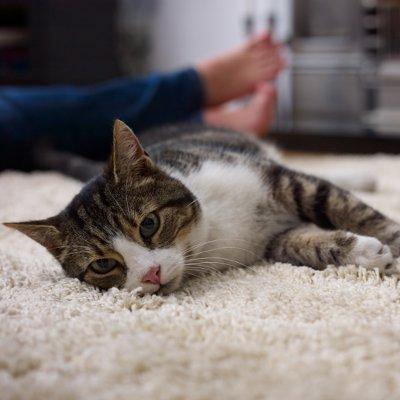By Dr. Julie Albright, PetSafe Small Animal Behavioral Chair at the University of Tennessee College of Veterinary Medicine
Are you considering adding another cat to your household? Owning multiple cats can be a lot of fun, but also frustrating if they do not get along with each other. Cats are territorial and do not naturally form bonds with all other cats. In fact, about half of new cat introductions result in serious and lasting aggression. A proper introduction between the resident cat and the new arrival can set the stage for long-term harmony in your home.
Create a Safe Zone
 Treat dispensing toys can provide the physical and mental exercise your pet needs when getting used to a new space.
Treat dispensing toys can provide the physical and mental exercise your pet needs when getting used to a new space.
Give the new cat a temporary space of her own safe zone such as a bedroom or bathroom away from other pets. Provide a litter box, water, food and mental enrichment. Treat-dispensing toys and vertical spaces like a cat tree or cleared bookshelf are great sources of entertainment when she is alone. It’s important to build a bond with your new friend during this adjustment period, so take time to quietly interact with her as well. Calming pheromones may also help ease the cat’s transition to her new home.
I suggest keeping the new cat in her safe zone for about two weeks, depending on her personality. A nervous cat may need more time in a small space away from other pets to acclimate to a new home. However, a bolder cat may become frustrated in a limited space. In this case, the introduction exercises should happen soon after she arrives.
Set Up a Gradual Introduction
The next step is a gradual introduction between your resident cat and the new cat.
Before they see each other, I recommend wiping one cat with a towel, then present the towel to the other cat. Then wipe this cat with the same towel and present it to the first cat. Repeat this process until the cats seem relatively unaffected by the scent of the towel.
Next, let the cats see each other through a barrier. A baby gate placed in a doorway is perfect for this exercise. Increase the chances of a smooth introduction by giving each cat a dish of her favorite food. Place the bowls far enough apart that the cats notice each other but are calm enough to eat. We want all early interactions to be pleasant ones so close the door as soon as the first cat has finished eating. Move the bowls closer together at the next session as long as the cats continue to eat and no hissing or growling occurs. Soon the cats will be eating very close together on opposites sides of the gate.
There are several options for the next step in the introduction. You can allow the cats to sniff without food, repeat the food bowl introduction without the barrier, or encourage them to play together with a feather toy wand. Many, but not all cats, continue to tolerate or even become friendly with each other after a controlled, reward-filled introduction. A veterinary behaviorist is a great resource for more information.



